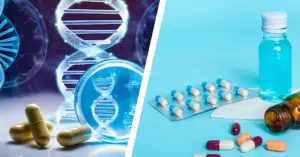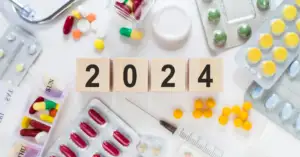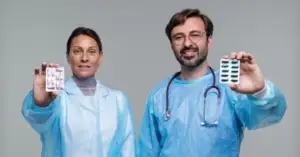There are different types of oral medicines. They are available as tablets, capsules, chewable tablets, and orally disintegrating tablets, which can be swallowed whole or dissolved in the mouth. Medications can also be in liquid forms, such as drops, syrups, or solutions. They are also available as powders and granules to be mixed with water and consumed as a liquid. Typically, the active ingredients in oral medications do not enter the bloodstream until they reach the stomach or intestines. In the intestinal lining, absorption takes place to enter into the blood circulation. Lozenges and oral disintegrating/ dissolving tables dissolve in the buccal cavity and enter the bloodstream bypassing the gastrointestinal tract. On the contrary, specific medications like certain laxatives have restricted absorption into the bloodstream as they are intended for local osmotic action in the intestine.
- Tablets:
Tablets are available in various shapes and sizes. They are easy to manufacture and have a long shelf life. To make tablets, one or more active ingredients are mixed with excipients (substances that help bind the tablet together) and then compressed into a solid form.
- Uncoated tablets- consist of tightly compressed powder or granules and typically have a dull surface. It is important to take these tablets with water to prevent them from getting stuck in the esophagus (food pipe) and to ensure there is sufficient liquid in the stomach for the tablet to disintegrate and dissolve properly.
- Coated tablets- which can be either sugar-coated or film-coated, have an additional coating to mask the taste and/ or to prevent deactivation by gastric juices. These tablets are smooth, often shiny, and easier to swallow, with a neutral or slightly sweet taste. Sugar-coated tablets are typically round or oval, while film-coated tablets have a thin coating. Tablets containing drugs that need protection from stomach acid are coated with a gastric acid-resistant layer (gastro-resistant tablets), ensuring the drug is released only in the small intestine. It is important not to crush or chew coated tablets, as this would remove the protective coating.
- Fizzy (effervescent) tablets- are designed to be dissolved in a glass of water before drinking. They are ideal for individuals who have difficulty swallowing tablets and often have a quicker effect than tablets taken whole, as the medication is already dissolved by the time it reaches the stomach.
- Chewable tablets and lozenges- These are designed to bypass the digestive tract for rapid systemic absorption. Orally disintegrating tablets- buccal tablets and sublingual tablets, are placed in the cheek pouch or under the tongue to dissolve slowly. This ensures rapid absorption of the medication in the bloodstream, where it then circulates throughout the body. Sublingual tablets have high solubility and disintegrate quickly in the mouth. They are recommended when instant action is required by making medicine available in the bloodstream instantly. They are therefore designed as a small, quickly disintegrating tablet to be kept under the tongue. The most famous sublingual medication is nitroglycerine tablets used by angina patients.
- Capsules and chewable capsules: Capsules are made of a shell, usually of gelatin, that contains medication in the form of powder, granules, or liquid. The shell dissolves in the stomach or intestines, releasing the drug. Capsules are durable, tasteless, and effectively preserve sensitive medications. There are also chewable capsules designed to be bitten, allowing the drug to be absorbed through the mouth’s lining.
- Time-release tablets and capsules: These are formulated to gradually release their active ingredients. A single time-release tablet can contain a full day’s dosage, distributing it evenly over 12 or 24 hours. This offers the convenience of needing just one tablet per day, eliminating the need for multiple doses.
- Powders and granules: Certain medications come in the form of powders or granules, such as some painkillers and many antibiotics for young children (dry syrup). These powders and granules are typically dissolved in water before being swallowed.
- Drops: In liquid drops, the medication is either the liquid itself or has been dissolved in a liquid, commonly water or a water-alcohol mixture. The dosage is administered by counting the number of drops.
- Liquid medicines and syrups: Liquid medicines usually contain one or more drugs dissolved in water, where the liquid itself can act as the medicine. These medicines often come with a measuring cup to make sure you take the right amount. People who have trouble swallowing pills often prefer liquid medicines. Syrups are strong mixtures of medicine and sugar.
Thus, ease of administration and advancement in drug delivery systems have made oral medications indispensable in modern-day medicine. This, in turn, leads to improved patient adherence and outcomes. Future developments in research and development may result in more innovative oral medications that address various patient needs, thereby expanding the scope of medical treatment.





